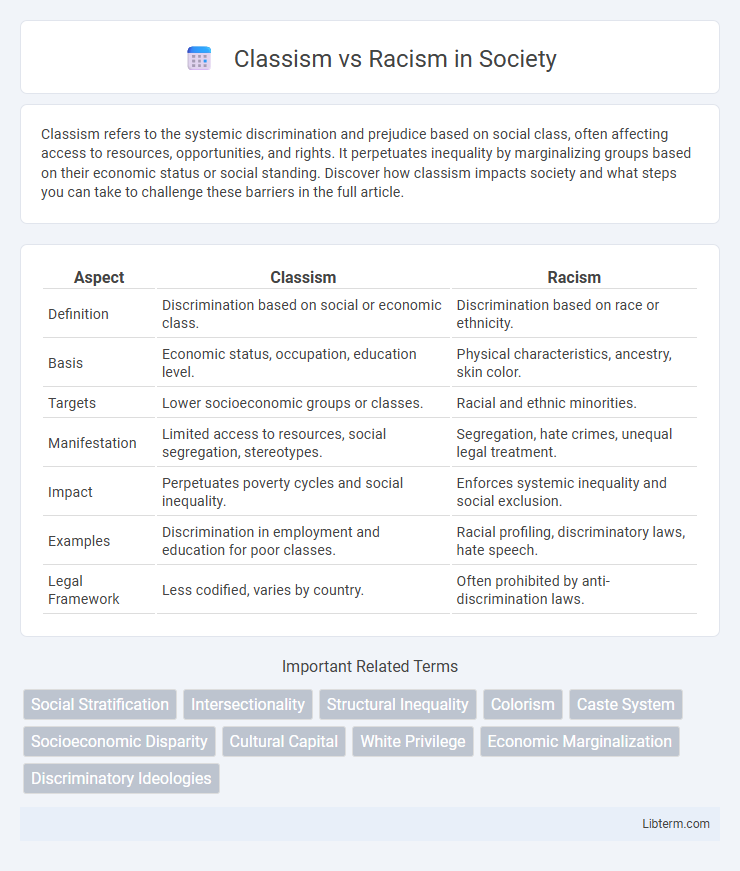Classism refers to the systemic discrimination and prejudice based on social class, often affecting access to resources, opportunities, and rights. It perpetuates inequality by marginalizing groups based on their economic status or social standing. Discover how classism impacts society and what steps you can take to challenge these barriers in the full article.
Table of Comparison
| Aspect | Classism | Racism |
|---|---|---|
| Definition | Discrimination based on social or economic class. | Discrimination based on race or ethnicity. |
| Basis | Economic status, occupation, education level. | Physical characteristics, ancestry, skin color. |
| Targets | Lower socioeconomic groups or classes. | Racial and ethnic minorities. |
| Manifestation | Limited access to resources, social segregation, stereotypes. | Segregation, hate crimes, unequal legal treatment. |
| Impact | Perpetuates poverty cycles and social inequality. | Enforces systemic inequality and social exclusion. |
| Examples | Discrimination in employment and education for poor classes. | Racial profiling, discriminatory laws, hate speech. |
| Legal Framework | Less codified, varies by country. | Often prohibited by anti-discrimination laws. |
Defining Classism and Racism
Classism refers to prejudice or discrimination based on social class, often manifesting through unequal access to resources, opportunities, and privileges between socioeconomic groups. Racism involves systemic bias, discrimination, or antagonism directed at individuals or groups based on their race or ethnicity, frequently resulting in social exclusion, economic disadvantages, and institutional oppression. Both classism and racism perpetuate social inequalities but target different aspects of identity and social hierarchy.
Historical Roots of Classism and Racism
Classism and racism both originate from systems of oppression designed to maintain power hierarchies, with classism rooted in economic and social stratification dating back to feudal societies and capitalist industrialization. Racism has deep historical ties to colonialism and slavery, where racial hierarchies were constructed to justify exploitation and discrimination. Understanding these historical roots reveals how economic status and racial identity have been manipulated to perpetuate inequality and social exclusion.
Key Differences Between Classism and Racism
Classism targets individuals based on socio-economic status, often discriminating against people with lower income or limited access to resources, while racism focuses on prejudice and systemic inequality rooted in race or ethnicity. The key difference lies in the basis of discrimination: classism is linked to economic class divisions, whereas racism is anchored in racial or ethnic identity. Both perpetuate social inequality but operate through distinct mechanisms and affect different demographic groups.
Overlapping Effects and Intersections
Classism and racism intersect through systemic inequalities that disproportionately affect marginalized racial groups, compounding barriers in education, employment, and healthcare access. Both forms of discrimination reinforce social hierarchies, limiting economic mobility and perpetuating poverty within communities of color. Understanding their overlapping effects reveals the need for intersectional policies addressing structural oppression beyond isolated racial or class-based frameworks.
Societal Impacts of Classism
Classism enforces social stratification by restricting access to resources like education, healthcare, and employment based on economic status, perpetuating cycles of poverty and inequality. This systemic discrimination fosters social exclusion, reduces upward mobility, and undermines social cohesion, leading to increased rates of mental health issues and crime in marginalized communities. The societal costs of classism manifest in entrenched economic disparities that hinder national development and exacerbate social tensions.
Societal Impacts of Racism
Racism systematically enforces power imbalances by marginalizing racial groups through discriminatory policies and social practices, leading to widespread inequality in education, employment, healthcare, and housing. This institutionalized prejudice fosters economic disparities, social exclusion, and psychological trauma, perpetuating cycles of poverty and reduced life opportunities for affected communities. Unlike classism, which categorizes based on socioeconomic status, racism is deeply ingrained in cultural, legal, and historical contexts that shape social hierarchies and access to resources.
Class Mobility Versus Racial Barriers
Class mobility often hinges on economic opportunities and education access, allowing individuals to potentially improve their socioeconomic status over time. Racial barriers, deeply embedded in systemic discrimination and social bias, frequently restrict access to these same opportunities regardless of economic background. Understanding the interplay between class mobility and racial barriers is essential to addressing social inequality in a comprehensive manner.
Media Representations: Class vs Race
Media representations often portray class and race through distinct but overlapping lenses, where classism is depicted via economic status and social mobility narratives, while racism is framed around systemic discrimination and cultural stereotyping. Films and television frequently emphasize racial identity with an emphasis on historical and institutional racism, whereas class narratives focus on poverty, wealth disparity, and access to resources. These portrayals shape public perception by reinforcing stereotypes, influencing policy debates, and underscoring the complex intersectionality between socioeconomic status and racial identity.
Combating Classism and Racism: Strategies and Solutions
Combating classism and racism requires implementing inclusive policies that address systemic inequalities in education, employment, and housing. Promoting diversity training and anti-bias education in workplaces and schools enhances awareness and reduces discriminatory behaviors. Community-based programs fostering cross-cultural dialogue and economic empowerment help dismantle both classist and racist structures.
Moving Toward Equity: Bridging the Divide
Classism and racism both create systemic barriers that hinder equitable access to resources, opportunities, and social mobility. Addressing equity requires deliberate policies that dismantle economic disparities while simultaneously confronting racial biases embedded in institutions such as education, healthcare, and criminal justice. Collaborative efforts that integrate anti-racist frameworks with economic justice initiatives foster inclusive environments where marginalized communities can thrive and achieve social parity.
Classism Infographic

 libterm.com
libterm.com